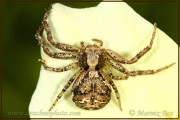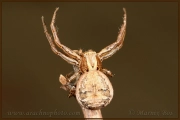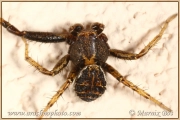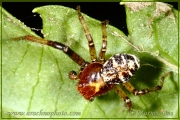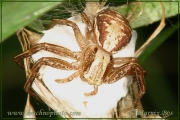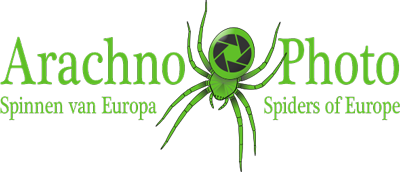These spiders have a broad and fairly flat crab-like body and a pretty good eyesight. The rear two pair of legs are much shorter and slimmer than the front two. They can quickly move sideways, just like a crab. Usually, they quietly sit and wait on a flower or a leaf until a prey comes close enough to grab it. It is then quickly overpowered. The prey is often significantly larger than the spider. Most Crab spiders are very well camouflaged (pattern & colour) to blend in with their surroundings. Some, such as the Flower Crab Spider (Misumena vatia), can even slowly change colour. In Europe more than 100 species can be found.
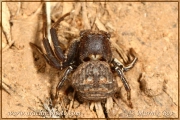
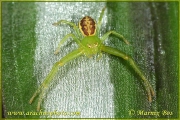
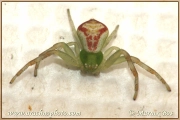
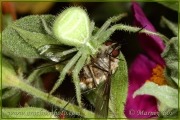
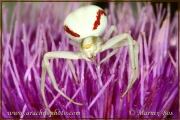
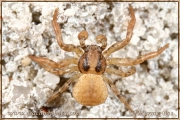
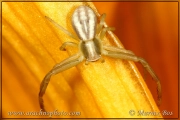
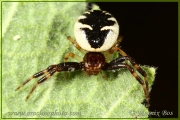
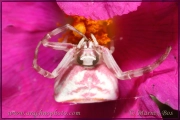
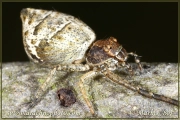
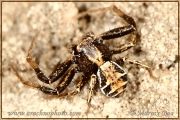
Genus Bassaniodes
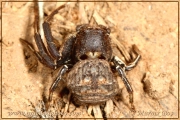
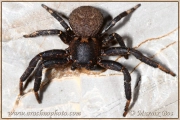
Genus Diaea
The spiders of this genus live and hunt on the leaves of trees and bushes. Therefore they come with a camouflage of predominantly green with brown markings on the abdomen.
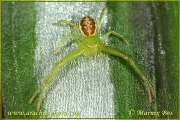
Genus Ebrechtella
These spiders (formerly genus Misumenops) are of about the same size, and as green as Diaea, but the abdomen is clearly broader and more triangular in shape. They occur on leaves of bushes, but often sit and wait for a prey inside a flower as well.
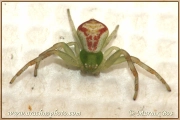
Genus Heriaeus
These easily recognizable spiders are different from the other Thomisidae because their body is completely covered with white or light green spines. Because of these hairs and their green body colour, they are very well camouflaged against the background of hairy stems and leaves of grasses and other plants.
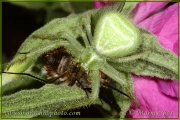
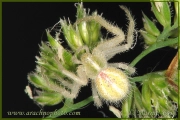
Genus Misumena
As well as Thomisus, Misumena can adjust its colour to the colour of the flower where it sits on. The process takes several days and is driven by their vision. This is only possible in adult females. The males do not have this ability and are also a lot smaller than the females.
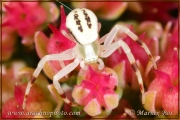
Genus Ozyptila
The spiders of this genus are smaller and more uniformly coloured than the other Thomisidae. They do resemble the Xysticus-species. They are highly variable in appearance, so that they are not so easy to distinguish from each other. Ozyptila mainly occurs on the ground, under stones or roots and sometimes higher in the vegetation, but almost never on flowers.
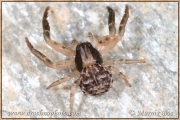
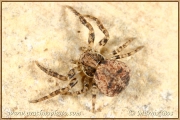
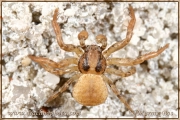
Genus Runcinia
These spiders live and hunt on bushes, flowers and grasses. They are yellowish and have a white band around the eyes. Males are darker than females and are a lot smaller.
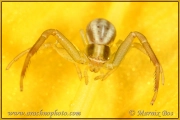
Genus Synema
The spiders of this genus live on plants, bushes and flowers, which are usually of the same colour as their body. They have a glossy white, yellow, orange or red abdomen showing a typical black pattern.
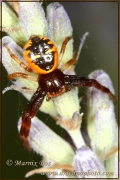
Genus Thomisus
As well as Misumena the female of Thomisus can change her colour within a few days. Thomisus can be recognized by the shape of the abdomen, which has two humps at the rear and therefore appears to have a triangular shape. Besides that, the outer eyes are located on pointy bulges. The spider occurs on flowers, where it lies in wait for prey.
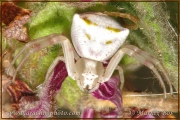
Genus Tmarus
The spiders of Tmarus do not resemble the other Crab spiders very much. They have a tubercle at the end of the abdomen. They take a characteristic pose, which resembles that of Tibellus: the front two pairs of legs stretched out on a twig. Because of their typically shaped abdomen and camouflage they closely resemble a bud of the plant.
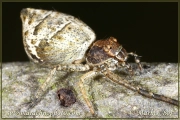
Genus Xysticus
The spiders of this genus are less spectacularly coloured than most of the other Thomisidae. They do however resemble the Ozyptila-species. They are often brown or grey with a leaf-shaped pattern on the abdomen. The species are highly variable and difficult to distinguish from each other. Usually they occur on low vegetation or on the ground.
